(Update: 8/8/24)—One year on, Welina Nūhou! Against a mise en scène of ashen gray, Lahaina’s cherished banyan tree shows fresh green shoots of by the day as the island slowly recovers. Of further news, Maui homeowners, businesses and other 2023 wildfire victims have now reached a $4bn compensatory settlement, $2bn of which will be paid by the Hawaiian Electric utility.
(10/8/23)—West Maui now broadly open for ‘vizness’, although not without some native misgivings, if not reports of local mis-takings, as in cozy sole source, no-bit rebuilding contracts.
Nevertheless, the famous 150-year-old ficus, which suffered through the August 8 firestorm—like virtually all of Hawaii’s former capital/Maui’s historic cultural center—was feared to have forever perished in the flames of the state’s deadliest natural disaster. But nearly two months on, the glorious ‘paniana’ landmark is generating viridescent new signs of life amid the ruins.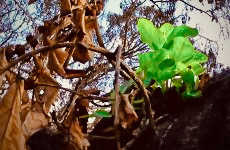
The news comes as Hawaii revises its official Lahaina death toll downward from 115 to 97, with missing-person numbers dropping to 66. Governor Josh Green also announced that west Maui will open to visitors on October 8, when travel restrictions will be lifted, at least in minimally or unaffected resort areas.
Meantime, allowable return to Lahaina burn sites, particularly for residents, will begin gradually—limited to zones cleared by the EPA to be relatively less hazardous. Locals will be advised to don protective gear, protecting against exposure to debris contaminated with toxic ash, asbestos, metals/plastics and chemicals. Residents and visitors alike will be able to reconnect with extinguished properties for minutes to several hours, reckoning with clean-up realities, reaching some degree of closure re grief and loss. Recovery teams will provide water, transportation, medical/mental aid through the painfully slow redemptive process, not likely to be fully completed for 3-4 more months.
Jumping Thru Hula Hoops.
All told, the wildfires severely decimated Lahaina—be it power/communications systems, health services, adequate housing, food/clothing essentials—all manner of a paradisal life once known. Not least ravaged has been Maui’s principal revenue source, namely travel/tourism.
Statewide, the post-wildfire visitor drop is estimated by the Hawaii Tourism Authority to be costing some $9m per day, and the industry remains under mounting economic pressure—even though much of the state was unaffected by the firestorm. Hence a University of Hawaii economic research study (UHERO) projects a state income growth of under 2% in fiscal 2024, tax levels shrinking dramatically, a General Fund rising barely 1.3% from 4% per fiscal year pre-fire.
Most afflicted is Maui itself, Hawaii’s tourism driver, with Lahaina hit hardest, of course—visitor arrivals to the Valley Isle down 70%, losing $13m per day, T/T-related unemployment rising above 11%. Add to that recovery losses escalating throughout this decade, a scenario where the sun don’t shine brightly for a long time. Even the rosiest of Maui pictures foresees a 50% return to 2022 revenue levels by year’s end, possibly 80% by late 2024. Meanwhile wildfire disaster-related investigations and lawsuits grind on–as in how prepared was the Hawaiian Electric utilities’ wildfire mitigation preparedness plan?
On the Come.
Come—don’t come—come after all: against this T/T economic free fall, Hawaii’s ‘stay away’ pleas since early August have given way to leis being the lay of the land. This, because many Sandwich Isle residents depend on tourism revenue to pay their bills.
So Maui tourism officials currently proclaim that much of the island came through the firestorm relatively unscathed, that central and south Maui have revived straight away and are ‘open’ for visitation. Indeed, a  $2.6m marketing campaign invites travelers to come back and support the island’s vast recovery effort. The promotional subhead goes along the lines of: ‘Forget trying to visit Lahaina’s immediate disaster area and broader west Maui for now. Moreover, please be respectful of the deep grief and loss you find here; and think about volunteering and tipping well when appropriate…for Hawaiians struggling to help Hawaiians sure could use the added support.’
$2.6m marketing campaign invites travelers to come back and support the island’s vast recovery effort. The promotional subhead goes along the lines of: ‘Forget trying to visit Lahaina’s immediate disaster area and broader west Maui for now. Moreover, please be respectful of the deep grief and loss you find here; and think about volunteering and tipping well when appropriate…for Hawaiians struggling to help Hawaiians sure could use the added support.’
Idea being: Locals are still going through all stages of trauma and grief, yet do appreciate visitors “coming to Hawaii with aloha again, so we can give them aloha back (land sharks excepted?).”
It’s up to us whether and/or when to ride this ‘come/don’t come/come again but…’ rollercoaster in the months ahead. All Vamigré can do for now is marvel at a greener paniana—even break out our cameras and ‘shoot-the-shoots’ every single, hopeful day. (MTC…)
![]()
Lahaina L’Amour.
(8/21/23)—But why Lahaina? And what now?
Consider L’heartbreak: 114 dead thus far, over 800 are still missing, more than 2,200 structures incinerated—horrific numbers counting and mounting, as search/rescue crews and cadaver dogs continue to comb the rubble and ash of Maui’s historic town. This while much of the island, from Kapalua to Hana 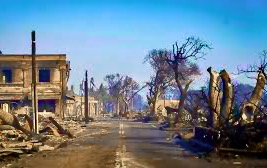 to Wailea-Makena weathered through Hurricane Dora’s wind-blown hellfire, emerging comparatively unscathed. Was it the luck of the drought-dry buffel/guinea straw, or haphazard leeward location, location, location? Seems only climatological and environmental forces will clear that air over time.
to Wailea-Makena weathered through Hurricane Dora’s wind-blown hellfire, emerging comparatively unscathed. Was it the luck of the drought-dry buffel/guinea straw, or haphazard leeward location, location, location? Seems only climatological and environmental forces will clear that air over time.
In any case, a spark possibly ignited up by a downed Kula powerline soon swept westward down from the Mauna Kahalawai range at nearly a mile a minute toward Lahaina. Local power and cell service suddenly cut off, nearly 13,700 residents and manifold summer visitors received little or no notification beyond a trickle of Maui County evacuation orders, while being conflictingly told to shelter in place. Trapped with so few passable roads in or out of town—many jumped a barrier wall, diving into Lahaina Harbor, fleeing to escape the onrushing wall of flames as fire department hydrants dried up—any casual humpback whale watching suddenly thrust overboard.
With all due respect, Lahaina isn’t Yellowknife or even Camp Fire, not Rhodes or Tenerife: it’s more on the order of a modern-day Pompeii—arguably even more physically devastating than that. All told, we’re witnessing the worst natural disaster in Hawaii’s history.
Breadfruit and Banyans.
It is held in local lore that Lahaina ‘a i ka malu ‘ulu o Lele’ (…lies in the shade of the breadfruit trees of Lele, its former name)—and is a vibrant and cherished place: By turns sacred ground, whaling village, 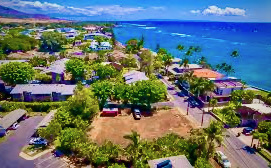 swashbuckling port of call, cool little beach/surf town beset by tourists and arriviste money-grubbers over the generations.
swashbuckling port of call, cool little beach/surf town beset by tourists and arriviste money-grubbers over the generations.
Initially, Lahaina was the capital of the Kingdom of Hawaii (and its spiritual center) in the 19th Century (1820-45), under the reign of King Kamehameha III, Kauhikea ou li. Many of Hawaiian Ali’i royal family were eventually buried in the Waiola Church Cemetery, sacred gravesites honored to this very day.
But by the mid 1800’s, Christian missionaries largely descended on Lahaina to convert, if not subvert Maui’s 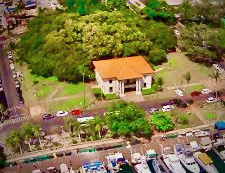 natives (albeit at the invitation of Queen Ka’ahumanu)—firmly positioning themselves in ‘pioneer’ houses about their Lahaina compound. The homes of Protestant leaders like Reverend William Richards and Dwight Baldwin were gradually converted to historic sites and museums–testament to Maui’s spiritual supplantation—save for the house of David Malo, renowned Hawaiian scholar and philosopher. Then again, missionaries from India donated an 8-foot banyan tree that Maui Sheriff William Owen Smith planted to commemorate 50 years of Protestant presence on the island in 1873, a Ficus benghalensis sapling which has since grown to 60 feet tall with 16 sprawling major trunks and an aerial root system lording over what became Banyan Tree Park.
natives (albeit at the invitation of Queen Ka’ahumanu)—firmly positioning themselves in ‘pioneer’ houses about their Lahaina compound. The homes of Protestant leaders like Reverend William Richards and Dwight Baldwin were gradually converted to historic sites and museums–testament to Maui’s spiritual supplantation—save for the house of David Malo, renowned Hawaiian scholar and philosopher. Then again, missionaries from India donated an 8-foot banyan tree that Maui Sheriff William Owen Smith planted to commemorate 50 years of Protestant presence on the island in 1873, a Ficus benghalensis sapling which has since grown to 60 feet tall with 16 sprawling major trunks and an aerial root system lording over what became Banyan Tree Park.
As to Lahaina’s more raucous, roisterous history, adjoining BTP is the Lahaina Courthouse itself, most recently a Lahaina Heritage Museum and Art Society. Within walking distance are the nearby Hale Pa’ahao “Iron’s House” Prison—coral block fortified for forced detention—and shifty Rotten Row. Not to mention the lighthouse and Old Fort ruins—built to protect the town from riotous sailors. Then repair to the Seaman’s House & Hospital, former party house for King Kamehameha III himself.
Beyond that, Lahaina’s livelier side comprised its compact, breezily strollable and cruisable city center—from mai tais at the Pioneer Inn to the ‘buzzy’ restaurants, bars/clubs and nightlife action along balconied 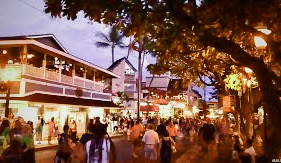 Front Street (née King’s Road): Kimo’s, Fleetwood’s, Old Lahaina Luau and all. So much palmy seaside revelry to soak in after a brilliantly sunny day of surfing, snorkeling, and/or shopping in Lahaina Town’s luminous shops and eminently worldly art galleries: Aloha spirit, spirits and stars galore…
Front Street (née King’s Road): Kimo’s, Fleetwood’s, Old Lahaina Luau and all. So much palmy seaside revelry to soak in after a brilliantly sunny day of surfing, snorkeling, and/or shopping in Lahaina Town’s luminous shops and eminently worldly art galleries: Aloha spirit, spirits and stars galore…
Alas, this cursory spin is but a fleeting glimpse of what has perished here, for greater Lahaina, as we know and love it, is now gone: the city’s humanity, flora/fauna, sacred sites and colorful history, its precious plantation style architecture, all having perished in the inferno winds.
Holy Masses to Bashes to Ashes.
With so much lost and still at stake, fingers began pointing every whichaway even before Hurricane Dora moved on. Where were the emergency warnings/evacuation orders, where was the disaster preparedness? Who/what started this hellfire? Where more precisely did it start, and what did the Hawaiian Electric 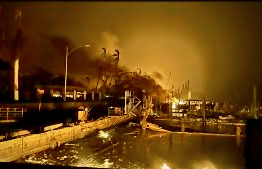 utility know or do about it, prevention-wise—given a viral video that allegedly revealed that power line sparking down into combustable dry grass overgrowth.
utility know or do about it, prevention-wise—given a viral video that allegedly revealed that power line sparking down into combustable dry grass overgrowth.
And what about those Maui-wide emergency sirens, which Hawaii termed part of “…an all hazards (state-wide) warning system”? Director of Maui’s emergency management agency Herman Andaya stated in a subsequent press conference that those sirens were meant specifically for tsunami warnings, to (wrongly) direct people up eastward toward the mountains. Said to have been out of town as the Laheinous fire blazed, Andaya soon cited health reasons for his ill-timed MIA and time-pressed resignation. Indeed, Maui County Mayor Richard Bissen was no less caught with his board shorts down when disaster struck.
FEMA and EPA investigators have since arrived on scene to join search/recovery crews desperately sifting and combing under flat sandwiched roofs; charred, gutted ruins and burned out vehicles for survivors, 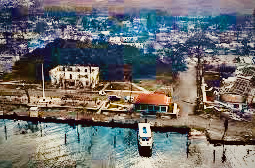 DNA identifiable remains and potentially further dangers. Meanwhile agency staffers help city officials address fire victims’ immediate medical care, supply/sustenance and housing needs—with President Biden landing in Air Force One to open the federal wallet. Longer term cost for rebuilding this popular slice of paradise: more than $5bn—on whose dime remains to be rightfully nailed down and hammered out over the critical months (daresay years) dead ahead.
DNA identifiable remains and potentially further dangers. Meanwhile agency staffers help city officials address fire victims’ immediate medical care, supply/sustenance and housing needs—with President Biden landing in Air Force One to open the federal wallet. Longer term cost for rebuilding this popular slice of paradise: more than $5bn—on whose dime remains to be rightfully nailed down and hammered out over the critical months (daresay years) dead ahead.
Maui vs. Haoles.
In any event, arriving as well have been legions of real estate speculator/developer types flashing greenback wads to buy up distressed Lahaina properties dirt cheap. The ‘land shark’ swarm has prompted Hawaii Governor Josh Green to seek a moratorium on sales of damaged/destroyed properties—particularly those belonging to vulnerable multi-generational natives.
Which also occasions the age-old onshore-offshore relationship Hawaiians have with non-native species—namely encroaching haole moneybags, vacation homesters, surf/beach crazies—all of whom devour natural treasures and drive up the cost of living for locals throughout the Sandwich Islands. But with a particular ‘huhū’ aimed at certain tourists and tourism in general.
Deep into the firestorm and its devastating wake, Lahaina officials “strongly discouraged” travelers from coming to western Maui and its popular towns and resorts—specifically to steer clear of suddenly overwhelmed search and rescue crews. The island’s decimated city remained closed to outside visitors for 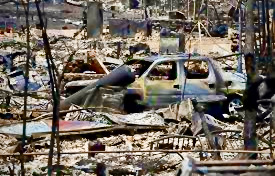 days, with the messaging that “…if you’re not from Maui, stay away.” Yet early on, besieged locals cited instances of lingering tourists already ‘behaving badly’: trodding through private property, parking illegally, clogging Lahaina’s narrow roadways, selfie-festing all over sacred, smoldering grounds. It seemed the entire state of Hawaii was souring against tourism—as if travelers were something of a straw man for reported local utility company under-investment, and grassland overgrowth.
days, with the messaging that “…if you’re not from Maui, stay away.” Yet early on, besieged locals cited instances of lingering tourists already ‘behaving badly’: trodding through private property, parking illegally, clogging Lahaina’s narrow roadways, selfie-festing all over sacred, smoldering grounds. It seemed the entire state of Hawaii was souring against tourism—as if travelers were something of a straw man for reported local utility company under-investment, and grassland overgrowth.
Before long, those emergency prohibitions did ease as Maui business interests called for some ‘return to normalcy’, arguing that “… it would be catastrophic if no one traveled to the island.” And that “…to normalize, we have to go back to tourism…so long as visitors “don’t impede Lahaina’s disaster relief 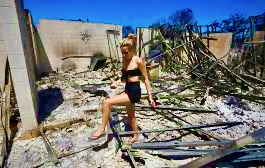 efforts.” Maui Chamber of Commerce officials, tour operators and shop/restaurant/barkeepers alike noted the inescapable numbers: A tourism dependent Hawaiian island with about 160,000 residents hosts some 70,000 visitors per day (most popular after Oahu); that 40% of Maui’s GDP and 50% of its jobs are bag-tagged to the tourism sector, with little means of escape since its sugar plantation fields were plowed asunder.
efforts.” Maui Chamber of Commerce officials, tour operators and shop/restaurant/barkeepers alike noted the inescapable numbers: A tourism dependent Hawaiian island with about 160,000 residents hosts some 70,000 visitors per day (most popular after Oahu); that 40% of Maui’s GDP and 50% of its jobs are bag-tagged to the tourism sector, with little means of escape since its sugar plantation fields were plowed asunder.
Paradise At a Price.
Clearly, Lahaina and larger Maui are of two minds when it comes to travelers and tourism, let alone the dollar/demographic divide on the islands overall. While business communities maintain that pricy island lodging, rentals and resorts have suffered extensive damage as well—declaring “…we must revive 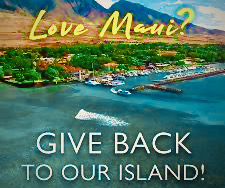 responsible and respectful tourism”—fully two-thirds of Maui’s locals believe the island is being run for monied tourists at their expense.
responsible and respectful tourism”—fully two-thirds of Maui’s locals believe the island is being run for monied tourists at their expense.
Local historians note that the Indigenous population lost out earlier when the U.S. government annexed Hawaii in the late 1800s, and that their hallowed spiritual ground has been piece-mealed away ever since. Native Hawaiians and/or struggling workers now fear Lahaina’s wildfire destruction will further inflame Maui’s economic and environmental tensions, that Maui’s cultural capital will become another corporate/lux Waikiki. Locals further claim that upwards of 40% of Lahaina’s housing was already being used for short- term rentals, and that haole speculator/developer money will have property and living costs erupting ungodly higher through the rebuild—forcing many everyday Lahainans off the island altogether, while tourism keeps ‘bringing it’, flight by flight.
term rentals, and that haole speculator/developer money will have property and living costs erupting ungodly higher through the rebuild—forcing many everyday Lahainans off the island altogether, while tourism keeps ‘bringing it’, flight by flight.
Guilt Tripping or Goodwill?
So where does this leave us, or take us? What role if any should travelers play in Lahaina’s recovery efforts? After all, is this disaster our fault? And where do we stand on the local faultlines? What do the city’s survivors want from us—what do the victim’s need? Does a scorched earth Lahaina wish us to stay away or help repave its way? Then again, should travelers avoid that tragic scene, disperse to elsewhere, be it on Maui or another island altogether?
And if we should head Lahaina’s way, what does our ‘best behavior’ amount to? Respectful, responsible;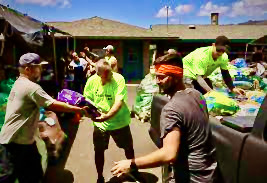 generously help not hinder; take ‘elsies’ not selfies at appropriate place and time; heed or get out of the way: Do we honor and console, or seek to help lighten the emotional load? Should we embrace the native Hawaiian spirit and heritage, or spirit ourselves away? Do we vend, value add or purely volunteer? Will we be handily disposed travelers or merely leering disaster tourists? Can we still swashbuckle some or do we humbly buckle under, as our paradise vacation hours melt swiftly in the prevailing tropical winds?
generously help not hinder; take ‘elsies’ not selfies at appropriate place and time; heed or get out of the way: Do we honor and console, or seek to help lighten the emotional load? Should we embrace the native Hawaiian spirit and heritage, or spirit ourselves away? Do we vend, value add or purely volunteer? Will we be handily disposed travelers or merely leering disaster tourists? Can we still swashbuckle some or do we humbly buckle under, as our paradise vacation hours melt swiftly in the prevailing tropical winds?
These and other why/wherefore issues the Lahaina tragedy raises will be explored as Vamigré sails forward. Meantime, all we can say for certain is it looks like that Courthouse Square banyan tree will pull through after all. Beyond that, Lahaina Manaoio—and L’Amour for evermore. (MMTC…)
#MauiStrong * MauiRecoveryFund.org * Maui United Way
(Among many other sources of relief)
